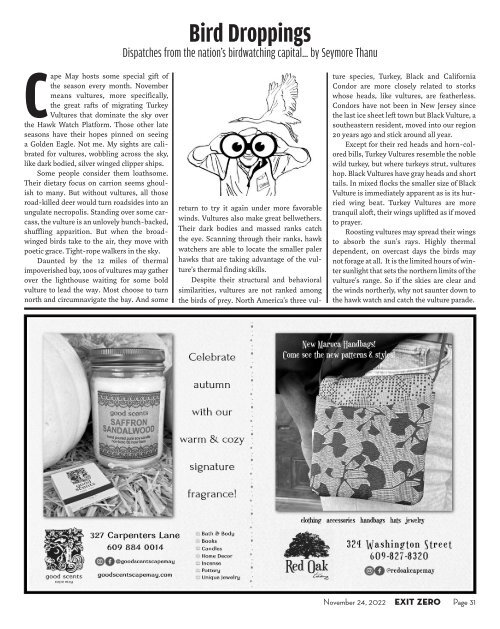V20 N42
November 24, 2022 V20 N42
November 24, 2022 V20 N42
- No tags were found...
You also want an ePaper? Increase the reach of your titles
YUMPU automatically turns print PDFs into web optimized ePapers that Google loves.
Bird Droppings<br />
Dispatches from the nation’s birdwatching capital… by Seymore Thanu<br />
Cape May hosts some special gift of<br />
the season every month. November<br />
means vultures, more specifically,<br />
the great rafts of migrating Turkey<br />
Vultures that dominate the sky over<br />
the Hawk Watch Platform. Those other late<br />
seasons have their hopes pinned on seeing<br />
a Golden Eagle. Not me. My sights are calibrated<br />
for vultures, wobbling across the sky,<br />
like dark bodied, silver winged clipper ships.<br />
Some people consider them loathsome.<br />
Their dietary focus on carrion seems ghoulish<br />
to many. But without vultures, all those<br />
road-killed deer would turn roadsides into an<br />
ungulate necropolis. Standing over some carcass,<br />
the vulture is an unlovely hunch-backed,<br />
shuffling apparition. But when the broadwinged<br />
birds take to the air, they move with<br />
poetic grace. Tight-rope walkers in the sky.<br />
Daunted by the 12 miles of thermal<br />
impoverished bay, 100s of vultures may gather<br />
over the lighthouse waiting for some bold<br />
vulture to lead the way. Most choose to turn<br />
north and circumnavigate the bay. And some<br />
return to try it again under more favorable<br />
winds. Vultures also make great bellwethers.<br />
Their dark bodies and massed ranks catch<br />
the eye. Scanning through their ranks, hawk<br />
watchers are able to locate the smaller paler<br />
hawks that are taking advantage of the vulture’s<br />
thermal finding skills.<br />
Despite their structural and behavioral<br />
similarities, vultures are not ranked among<br />
the birds of prey. North America’s three vul-<br />
ture species, Turkey, Black and California<br />
Condor are more closely related to storks<br />
whose heads, like vultures, are featherless.<br />
Condors have not been in New Jersey since<br />
the last ice sheet left town but Black Vulture, a<br />
southeastern resident, moved into our region<br />
20 years ago and stick around all year.<br />
Except for their red heads and horn-colored<br />
bills, Turkey Vultures resemble the noble<br />
wild turkey, but where turkeys strut, vultures<br />
hop. Black Vultures have gray heads and short<br />
tails. In mixed flocks the smaller size of Black<br />
Vulture is immediately apparent as is its hurried<br />
wing beat. Turkey Vultures are more<br />
tranquil aloft, their wings uplifted as if moved<br />
to prayer.<br />
Roosting vultures may spread their wings<br />
to absorb the sun’s rays. Highly thermal<br />
dependent, on overcast days the birds may<br />
not forage at all. It is the limited hours of winter<br />
sunlight that sets the northern limits of the<br />
vulture’s range. So if the skies are clear and<br />
the winds northerly, why not saunter down to<br />
the hawk watch and catch the vulture parade.<br />
November 24, 2022 EXIT ZERO Page 31


















